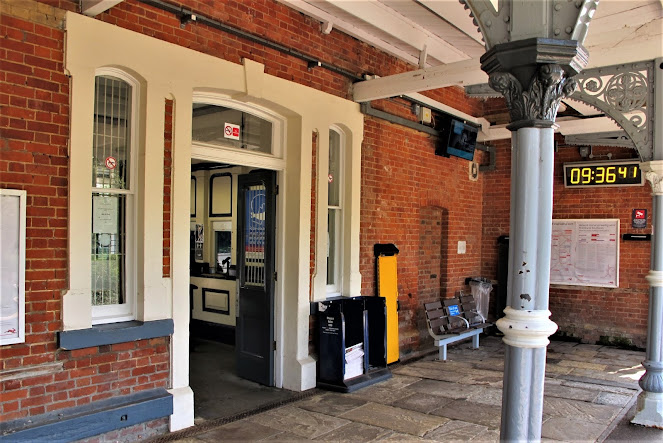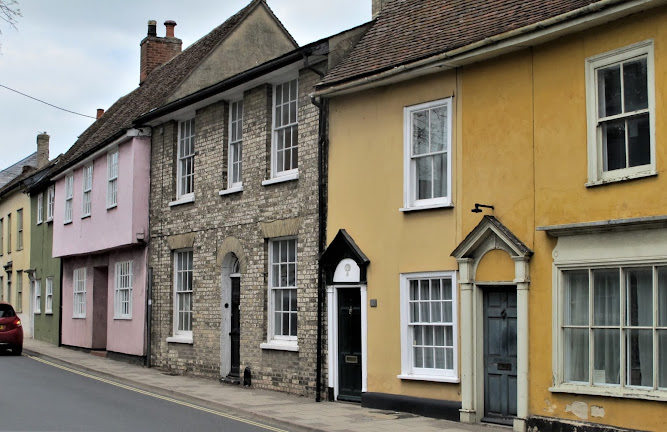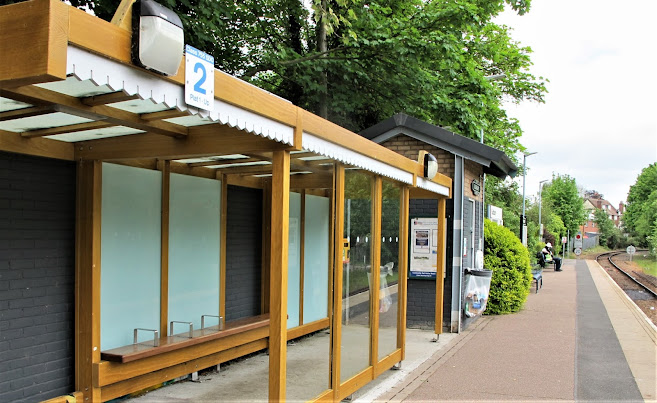On Thursday, my best looking, most intelligent and highly talented niece, called me to a meet. This meant heading for Sudbury. For reasons unknown she and him were spending a week at Bury St Edmunds and wished to see me. Having not met for well over 18 months and with her expecting in September it was important to meet now, but how? He does not drive, I have no car, and no bus runs between here and there (Thank you Mrs Thatcher!). After much thought and confusion, a reading of timetables, still a difficult operation, in the end they caught a bus to Sudbury and I took the train. I still pray for the maroon Landrover to arrive, still waiting...
Train travel as you know, is a simple matter of taking the train to Witham, changing, travelling two stops to Marks Tey, changing into the one grubby coach, travelling three stops to Sudbury. Easy.
So, rising before dawn, I shuffled down the slope to the station early, just to ensure I got a ticket from the man and did not have to use the complicated machine. I was able to make use of my 'Railcard' and get some money off the cost. First time in two years I think. The night before I checked the 'Greater Anglia' website and looked at the various prices. If I set a time the journey cost it £10:60. If I had an 'open return,' the cost was £16:50. At the station in the morning I paid £11:05, no wonder the rail staff are confused about ticket prices today? I chatted to a gran showing the child the railway and soon I was aboard the high speed express, 30 mph at times, heading south.
Easy?
Naturally, at Witham confusion reigned!
The signals had failed between here and Marks Tey, two stops of trouble! In this picture you see the Norwich train awaiting instruction in the loop, on the right the Ipswich train also awaits while behind us, as seen in the previous foto another Norwich train arrives These usually have at least 30 minutes between them. The two railway employees were doing wonders in the situation as every passenger (sorry, customer) had the same question and the poor lads had no answers.
Quicker than expected the 'all clear' was given, instructions announced, and I now had to clamber up stairs and down to catch the Ipswich service as that was now going to stop at Marks Tey, if the driver remembered. Apart from my knee giving way and almost falling down, a workman reached out his hand to stop me, there were no more mishaps and the destination was reached.
Indeed the passengers, like the workman, were mostly pleasent to one another in this confusion, no blame being attached to the workers either.
At Marks Tey the change was simple, the platforms merging into one another. Much to my surprise the grubby coach no longer runs, replaced during LockDown by this glamerous three coach set. Very nice indeed I must say.
While many travelling had been affected by the short disruption there was a healthy use of this train, clearly much used during commuter hours for those travelling to London or in the other direction towards Ipswich.
Having not been anywhere for so long it was good to view the acres of green fields with early crops beginning to show through. Occasional cattle, small villages with houses priced so high no pleb will be moving there anytime soon, a church spire here, a tower there, trees and bushes lining the track, something not allowed in days of steam. Altogether a bright day with a colourful landscape, such a change from being indoors. The recent weather harming the windows prevented any chance of a picture from the train, this one does not see the washing machines daily obviously. So far, an enjoyable and 'interesting' day out.
I was quite surprised to see my niece, young attractive, slim, as I half expected to see a bell tent on legs, but it is far too soon for that, maybe August. James, her owner, looked as expected, balding more I noticed, come Christmas what he has left, may well be pulled out of course.
Here we have one of life's mysteries. How come and attractive talented young woman in London cannot find a rich man? How come she ended up with a hill walking university librarian as opposed to a rich man with a yacht in the Med?
I will never understand women, and James has probably found he will never understand them either to his cost!
'Sudbury,' meaning 'South of Bury,' has been around since Saxon times, the twice weekly market, which was busy when we passed by, itself being over a thousand years old. The town became wealthy in the days of long ago through the Flemish weavers who flooded into East Anglia, many sheep in the area and judging by the size of the ancient 'Corn Hall,' now used as a library, there was great money in agriculture also.
Certainly some people made a great deal of money in times past but looking up house prices I find Sudbury to be considerably cheaper than this area. These house on Gainsborough Road maybe no more than £350,000. You can of course pay a million nearby if you wish but round here these would add a hundred thousand to the price. There is still a great deal of money in Suffolk but being further from London may keep prices down.
We found a cafe for tea and cake and a chance to natter, more about the cafe later, and wandered back and forth along the main street, there not being much else to see. There was limited time as even on holiday my niece chose to follow up on her piano teaching work, money makes demands, and had to return for a certain time to their high class lodgings. I hope the tent was dry. Sudbury is a small Bury St Edmunds with a mains street, a big church, no longer used, indeed it has three medieval churches and a famous archbishiop called Simon Sudbury. He had arranged for a Leper hospital to the north of the town and has also come up with the idea of the Poll Tax. This however, in 1381, did not go down well with the natives. They collected him from the Tower of London, took him somewhat unwillingly to Tower Hill and chopped his head off, eventually, as it took 7 or 8 strokes. Some 'Brass Neck' on an Archbishop. Why did we not do this with Maggie when she had the same idea? Simon's body was buried in Canterbury but his head remains in St Gregory's Church, Sudbury. Maybe we ought to have gone and had a look?
We wandered past Gainsborough's House, he was not in as the workmen were renovating it. Famous as a landscape and portrait painter a statue was erected in 1903 to commemorate the man, long after he was dead you note. At the OU I had to comment on one of his pictures, that of Mr & Mrs Andrews of around 1748. It was said he wanted a landscape and they a portrait, whether this is true or not it is fact that he had his landscape and put them at the side of it. Very well done.
In amongst the wealth of weaving, agriculture and the vast array of vehicular traffic the townspeople, all 14,000 of them struggle to survive like the rest of us. I wonder what proportion take the early train to Ipswich or London?
Too soon in my opinion came time to depart. Parting is such sweet sorrow, well no, it isn't! I was enjoying them, James is a great man and will fit in this deranged family very weel, he comes from Burnley you see. Burnley, it is a place up north, I believe they call it 'Blackburn's little brother,' but I will have to check that. They clambered aboard the bus that took them round all the houses and through the suitably named 'Long Melford,' another place well worth a visit if you ever venture up that way, and I hurried to the station to catch the train that would be soon to depart wiping away tears from my eye.
Naturally, I had read the timetable wrong, it was not 46 mins past but 26!
This meant a wait in the sun, which was fine by me. This short platform here is extremely well kept, I wonder if volunteers do this rather than staff? I suspect that as there are no permanent staff it is indeed a voluntary job, well doen to them! Neat and tidy with a background of varied plants it is a welcome resting place for the traveller.
Not only do the birds get a home made for them...
So do the bees...
Wildlife must flourish in such circumstances, here's another enjoying life here.
It once was common for railways stations to be a gardeners delight. Dunbar I believe still is, and many others have some attempt at improving the environment. Staff themselves probably have less time today, certainly at bigger stations, and in such places the public may be less concerned with the surroundings. I consider Sudbury Station a wee treasure. Awaiting a train in the sun is a delight when birds sing in the trees, creatures move around amongs the flora opposite and you know people appreciate the surroundings.

On time as always the 335 arrives and soon we were heading home. On the way the conductor (what we used to call 'guard') chatted amiably. Ian, his name, explained the difficulties of his job re ticket pricing. So many railcards (Indeed, I counted 28 on the website) some of course only for certain parts of the country, all making Ian's job difficult. On this train the conductor collects fares, no ticket booth at such stations, add to this a crowded train, a short journey and the mad rush you could see how he enjoyed this late, quiet, shift. It is not unusual to find rail staff friendly on the quieter lines.

We sauntered across the famous Chappel Viaduct, some 32 spans made from around 7 million bricks. Completed in 1849 it reveals why so many young men became bricklayers. A 'Brickies' life, or indeed a Bricklayers assistants life, in Victorian days was one of constant work. Railways required bridges, buildings and a wide variety of other constructions. A great housebuilding increase saw towns spread out and follow rail lines, no wonder there are so many 'Bricklayers Arms' to be found in the nation. It was at such pubs that men would gather once a week and pay their 'subs.' Usually a sixpence would cover it, if they fell ill or were injured they could then draw a few shillings a week to keep them alive, hence the pubs took their name. Just imagine how many bricks are in the buildings around you now, Victorian made and still doing their job.
By now my feet as well as my knees were telling me to go home. Naturally, at the modern Marks Tey Station to cross the line you use the stairs. I have my own opinion on stairs. This modern station has no lift! How do you cross in a wheelchair? I captured this train arriving, to slow to rush down, and allowed it to depart knowing another would be along soon enough. I then clambered up another flight to the coffee shop in the main entrance only to find it closed because of Covid! I was pleased.
So I waited in the shelter as Norwich trains raced by, on time now, and the Liverpool Street from Norwich rushed the other way. Why do I find such things entrancing? I just wish they were steam!
Every station has a numpty taking pictures of trains, some staff object, others don't care. Here a dirty look from the far side from someone, possibly not working on the railway, failed to discourage me. I was Thursdays train numpty. How I was enjoying being allowed out!
I note nobody else was enjoying me being out however.
I clambered up the stair at Witham muttering many things unfit for this gentle blog, I muttered much more when at the top I remembered they do have lifts at WithamI So I descended gracefully by the lift to the platform. By the time I reached the end of the busy station the train arrived. The short sun filled wait at quiet Marks Tey being better than a longer wait at this now busy place.
Soon I was hobbling up the Hill, a hill I used to refer to as a slope. Once I hardly noticed the slope, now I trudged on feeling like I was in the Cairngorms and not Essex. This was made worse by realizing I had failed to take anything from the freezer last night and now, for some reason being hungry, I was forced to trudge round Tesco and struggle home with a bag of ready to cook pasta. Another staircase, a fight with an oven, a burnt pasta mess, tastless, burnt, but all eaten no matter what, and bed with a very stiff drink to stop me from calling an ambulance. Totally whacked, soon out for the count.
Today's breakfast...
I must say I was really glad I saw them.





























.jpg)












































